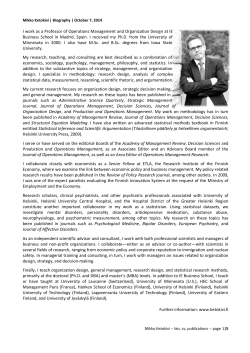
The Position of Finnish Women
The Position of Finnish Women: Regional and Cross-National Comparisons ELINA HAAVIO-MANNILA* The position of women in Finland is compared with that in the other Scandinavian countries and the Soviet Union on the basis of census and interview data. The high proportion of women at the universities, in the labor force, and in the parliament is accompanied by a traditional division of labor at home and by traditional attitudes towards equality of the sexes in society and family. This discrepancy between (1) formal behavior and (2) informal behavior and attitudes causes strain. A radical sex role debate has for some years been conducted in order to bring changes in the situation. The political activity of women in eastern Finland points to some kind of "matriarchal" tradition there. The attitudes towards women's and men's equality are more favorable in eastern than western Finland, too. However, no difference in the division of house hold tasks can be seen between these parts of the country. Women in eastern Finland take care of the housework even when they are active in society. According to international comparisons, Finnish women may in general be characterized as active but not very strong nor appreciated. the other on the semantic differential study of ten cultures by Charles E. Osgood. There are clear regional differences in the position of women inside Finland. Such differences reflect the international comparison of East and West and are thus of interest in this connection. ROSS-cultural variation in the degree of sex role differentiation can be studied on two levels: the behavioral and the attitudinal. Behavior and attitudes usually correspond to each other, but situations may arise when there is discrepancy between them. On the societal level this may indicate a situation in which the generally approved expectations are not realized in the actual practices of people. As a consequence of this discrepancy, legislation and social services—which are dependent on general attitudes as well as on official ideology—may not meet the actual needs of the people. Comparison of different nations offers an opportunity to investigate on a general level the consistency of expectations and behavior. Behavior can be studied on the basis of official statistics and interview data. Measurement of attitudes gives some information on the normative expectations in a country. In the following analysis the position of women in Finland will be compared with that of the other Scandinavian countries—Sweden, Norway, and Denmarkand the Soviet Union. The position of women is compared with that of men. It is nowadays customary in Scandinavia to talk about sex roles and not only about the woman's role. The "biased" title of this article has been chosen because we are discussing sex roles mainly from the point of view of women. Apart from the comparison of these five countries, some wider comparisons between nations will be made. One is based on a worldwide factor-analytic study made by Jack Sawyer, The position of women in any society can be compared with other variables indicating various aspects of the social system and its development. Jack Sawyer has made a factor-analytic study of 82 nations based on 236 social, economic, political, and other characteristics assessed in 1955. 1 The main factors which explained 40 percent of the total variance in the original matrix were size, wealth, and politics. Closely indexing these three dimensions were three variables, among themselves practically uncorrelated: population, gross national product per capita, and political orientation—Communist, neutral, or Western. These three variables sort nations into groups of considerable homogeneity. Two indicators of the position of women are included in Sawyer's report, published in the American Journal of Sociology: the proportion of girls among primary and secondary school pupils and the proportion of female workers in the labor force. The former is mainly correlated with wealth (correlation .65 with gross national product per capita) ; the latter with politics (correlation .35 with Western politics). * Elina Haavio-Mannila, Doctor of Social Sciences, is Docent of S,ociology, University of Helsinki, and Senior Research Fellow, Finnish Social Science Research Council. 1 Jack Sawyer, "Dimensions of Nations: Size, Wealth, and Politics," American Journal of Sociology, 73 (1967). pp. 145-172. May 1969 INTERNATIONAL AND HISTORICAL BACKGROUND JOURNAL OF MARRIAGE AND THE FAMILY 339 Correlations with the other variables are in both cases very low. In the wealthy nations girls are usually educated, while women in the labor force are a characteristic of the Communist countries. Finland is a spedal case as regards the position of women. Women attend institutions of higher education more often than in almost any other country in the world: from 1965 onwards 50 percent of the students at the universities have been girls. Participation in the labor force is also high: in 1960, 48.5 percent of the females over 15 years of age were economically active. Finland is neither wealthy nor communist. Why, then, is feminine participation in both education and the labor force so high? And as regards suffrage, why were Finnish women, as long ago as 1906, the first in Europe and the second in the world to get the vote ? In anthropological studies, theories—for example, functionalist or evolutionary theories— can seldom account for more than part of the distributional facts. After that we must resort to historical-diffusionist theory in an attempt to explain them.2 The situation of women in Finland does not fit into the general pattern of factors which explain women's position. We have to treat it in the light of its special historical and geographical circumstances. Historically, Finland was part of Sweden until 1809, when she became an autonomous part of Russia. In 1917 she achieved political independence. Social and cultural ties with the West have been stronger than those with the East. Even under the Russian regime Swedish legislation was kept in force. In eastern Finland 2 Robert Marsh, ComParative Sociology, New York: Harcourt, Brace & World, Inc., 1967, p. 65. TABLE 1. PERCENTAGE OF FEMALE STUDENTS AT THE SECOND AND THIRD LEVEL OF EDUCATION IN SCANDINAVIA AND THE SOVIET UNION IN 1965, IN PERCENT Education at the Second Level Country Norway Denmark Sweden Finland Soviet Union Education at the general vocational Third education education Level 49 52 55 54 552 37 28 49 37 47 22 36 34' 49 43 1 In 1961 2 In 1955 Source: UNESCO Statistical Yearbook 1965, Mayenne, 1966, pp. 198-265. 340 the Eastern influence, for example, through the Greek Orthodox religion cannot be disregarded. Cultural diffusion has taken place from both East and West. The Finnish language belongs to the Finno-Ugric group, the same one to which the Estonian and Hungarian languages belong. It is quite different from the Germanic and Slavic languages of the neighboring peoples. Thus separated linguistically from its neighbors and isolated geographically, Finland may be regarded as a cultural pocket characterized by some special features of its own. To give some basis for comparison, the gross national product of the four Scandinavian countries and Russia in 1965 will be presented: Sweden Denmark Norway Finland Soviet Union $2,130 per person 1,740 1,620 1,550 1,000 Finland is halfway between Sweden and Russia and very close to Norway. FINDINGS Cross-National Comparisons Differences in behavior. The special position of women in Finland will now be examined from the point of view of formai and informal behavior and of attitudes, As indices of formai behavior, the participation of women in education, occupational life, and politics will be discussed. At the high-school level of education, the proportions of girls among pupils receiving a general education are fairly similar in the Scandinavian countries and the Soviet Union (Table 1). Only Norway has a low percentage compared with the other countries. Vocational training takes in the highest proportion of girls relative to boys in Sweden and the Soviet Union. It is at the university level of education that the ratio of women to men is higher in Finland than in these other countries. In Norway this percentage is very low. The proportion of economically active members of the total male and female population can be seen from Table 2. Among women it is highest by far in the Soviet Union and lowest in Norway. Finland has a much higher percentage of gainfully employed women than the other Scandinavian countries. This situation has already been pointed out and discussed by Harriet Holter.3 Harriet Holter, "Women's Occupational Situation in Scandinavia," International Labour Review, 93 0966), pp. 9-11. JOURNAL OF MARRIAGE AND THE FAMILY May 1969 TABLE 2. PERCENTAGE OF ECONOMICALLY TABLE 3. PERCENTAGE OF WOMEN AMONG ACTIVE POPULATION OF TOTAL MALE AND THOSE ELECTED IN PARLIAMENTARY AND FEMALE POPULATION IN SCANDINAVIA IN LOCAL ELECTIONS IN SCANDINAVIA AND THE SOVIET UNION (YEAR OF ELECTION) 1960 AND SOVIET UNION IN 1959 Country Men Women Country Norway Denmark Sweden Finland Soviet Union 60.6 63.7 60.9 57.5 55.8 17.8 27.9 25.7 34.8 49.3 Norway Denmark Sweden Finland Soviet Union Parliamentary Elections 9.3 (1965) 11.2 (1967) 13.3 (1964) 16.5 (1966) 28.0 (1966) Local Elections 6.7 (1963) 9.7 (1966) 12.0 (1966) 7.9 (1964) 42.8 (1967) Source: International Labour Office, Yearbook o Labour Statistics 1967, Geneva, 1967, pp. 31-40. The political participation of women in parliament and in local government is shown in Table 3. The proportion of women in parliament is highest in the Soviet Union, next highest in Finland, and lowest in Norway. In the local elections in Finland, women have not been as well represented as in Sweden and Denmark, but even here the Norwegians have the lowest percentage. The Soviet Union has a much higher proportion of women then the Scandinavian countries. In the local elections of 1968 in Finland, a campaign was launched by women's organizations to get women in, and their proportion rose to 11 percent. Participation in voluntary organizations among women is not especially lively in Finland. The percentage of membership among married women in two small towns in Norway and in the whole of Denmark is higher than among the married women in Gothenburg in Sweden, and in the whole of Finland, according to preliminary results obtained from unpublished studies made by members of the Scandinavian sex role research group. 4 In their behavior outside the family, Finnish women are active in acquiring higher education 4 Barbro Jansson, in Gothenburg, and Johannes Noordhoek, in Copenhagen, are members of the Scandinavian sex role research group and have provided information for this report. Data from Norway have been attained from Biorg GrOnseth, "En undersökelse av husmodres sosiale situasion og deres behov for opplysning og veiledning," Oslo: Institutt for Samfunnsforskning, '1965 (stencil) . and gainful employment but are not particularly well represented in politics or voluntary organizations. Data on family relationships in Scandinavia show that the age difference of the spouses is lower in Finland than in the other Scandinavian countries (Table 4) . This would suggest a fairly egalitarian relationship between husband and wife in the family. There are no comparative studies from all of the countries examined here. We may only mention some studies in which Finland and Sweden have been compared at the informal level of behavior at home. In 1966 some 750 interviews were conducted on both sides of the Swedish-Finnish border in the north, and some questions about family life were included. The Finnish families were more traditional in the division of household tasks than the Swedish ones. The Swedish husbands participated more in washing the dishes, preparing food, and cleaning the house. In 60 percent of the Finnish farm families, the wives were solely responsible for the cattle; in only about 30 percent of the Swedish farms was this so. In Sweden the husbands participated more in this job, and outside help was also more often available. Socialization of the children into religion, for example, was in Finland more often done by the mother alone; in Sweden by both parents. Household duties, care of livestock, and education of children were thus conducted in Finland mainly by the wife alone. The modern companionship family was more prevalent in TABLE 4. MEDIAN AGE AT FIRST MARRIAGE IN SCANDINAVIA IN 1960 Norway Denmark Sweden Finland Men Women 25.7 24.9 25.7 24.5 22.6 22.3 22.8 22.6 Source: Leena Bogdanoff, Perhe ja avioliitto Pohjoismaissa thesis in sociology, University of Helsinki, 1967, p. 35. May 1969 Difference 3.1 2.6 2.9 1.9 (Family and Marriage in Scandinavia), master's JOURNAL OF MARRIAGE AND THE FAMILY 341 TABLE 5. TIME BUDGETS (IN HOURS AND MINUTES) IN HELSINKI, MOSCOW, AND NOVOSIBIRSK, BY SEX Type of Activity Helsinki Moscow and Novosibirsk Men Women Men Women 7-40 5-57 Leisure* Sleeping* 1-50 6-44 7-46 4-41 5-09 8-13 7-25 1-52 2-00 4-10 8-28 6-18 1-22 5-38 2-22 8-14 Total hours 24 24 24 24 Earning and productive activity* Travel to work Housework and connected activity * In Helsinki travel is included in earning and eating is included in leisure; in Moscow and Novosibirsk, in sleeping. Source: Data from Helsinki were collected in 1966 by the author from 444 interviewees aged 15-64 representing the total population of Helsinki. Data from Moscow and Novosibirsk have been obtained through University of Ta llin , from c~o~...~~, ed".: 4'9 0. Sweden. Decision-making in the family was in Finland somewhat more often in the hands of the husband, but this difference was small. In both countries the wives more often than the husbands made family decisions. Unpublished data from Uppsala and Helsinki give the impression that the division of household tasks is about the same in these two cities. We may conclude that Finnish wives more often than Swedish ones are in practical charge of their families alone but that their power in family decision-making is at least not greater than in Sweden. The independence of Finnish women can thus be seen in their single-handed performance of household tasks in the family. The Finnish wives have a large amount of work at home even though, as shown above, they often work outside the home. Time-budget studies from the Soviet Union and Finland show that Finnish women spend less time on housework than Russian women but that men spend about the same amount of time on it (Table 5) . Thus the difference between men and women is greater in Russia than in Finland. Furthermore, a comparison of Hungary and Finland revealed that the difference in the amount of time spent on housework by men and women is greater in Hungary than in Fin- land. 5 These results indicate that in the east European socialist countries the division of labor between the sexes at home is more traditional than in Finland. Finland, on the other hand, may be more traditional than Sweden. Informal sex role behavior thus does not correspond to formal behavior. Family conditions may be further described on the basis of official statistics. Birth and divorce rates might give some indication of the situation of women in the family. Until recently the birth rate has been higher in the Soviet Union and Finland than in the other Scandinavian countries, especially Sweden (Table 6). Only in the past decade has there been a considerable decline. Thus a low birth rate did not precede women's activity outside the home in Finland. In Scandinavia the divorce rate, except for the postwar period, has been next to lowest in Finland; it is by far the lowest in Norway (Table 7) . In the Soviet Union the divorce rate is higher than in Scandinavia. The lower rate of industrialization in Norway and Finland may be the explanation for a low divorce rate. In the Veronica Stolte Heiskanen and Elina Haavio-Mannila, "The Position of Women in Society: Formal Ideology vs. Everyday Ethic," Social Science Information, 6 (1967), p. 185. TABLE 6. CRUDE BIRTH RATES IN SCANDINAVIA AND SOVIET UNION IN 1950-1966 Norway Denmark Sweden Finland Soviet Union 1950-54 1955-59 1960-64 1965 1966* 18.7 17.9 15.5 22.8 26.4 18.1 16.8 14.5 19.9 25.3 17.3 17.0 14.5 18.1 22.4 17.5 18.0 15.9 16.9 18.4 18.4 15.8 16.7 18.2 * Source: United Nations Demographic Yearbook 1966, New York, 1967, pp. 217-219. 342 JOURNAL OF MARRIAGE AND THE FAMILY May 1969 TABLE 7. DIVORCE RATES PER 1,000 POPULATION IN SCANDINAVIA AND THE SOVIET UNION IN 1936-1965 Norway Denmark Sweden Finland Soviet Union 1936 1940 1945 1950 1955 1960 1965 0.35 0.86 0.45 0.40 0.32 0.91 0.55 0.36 1.10 0.62 1.45 0.97 1.49 0.71 1.61 1.14 0.92 0.40 0.58 1.53 1.21 0.85 0.66 1.46 1.20 0.82 1.30 0.69 1.37 1.24 0.99 1.60 Source: United Nations Dernographic Yearbook, 1953, 1961, and 1966; and Vestnik Statistiki No. 1 (1965), pp. 93-96; and No. 12 (1966), p. 93. Soviet Union a different legislation may count for the high divorce rate. No clear relationship between divorce rates and position of women can be seen. The investigation of sex role behavior in Scandinavia and the Soviet Union has given the following results: the formal economic, educational, and political activity of women increases from west to east. In the home the informal division of labor between the sexes is, however, most traditional in the Soviet Union, next most traditional in Finland and least traditional in Sweden. Differences in attitudes. We have found some clear differences in the sex role performance between the Scandinavian countries and the Soviet Union. Are these differences reflected in the sex role expectations or norms ? If there exists a consistency between public behavior and attitudes, the sex role norms should be more equality-oriented in the east than in the west. Unfortunately we do not have any information about the general attitudes or public opinion in Russia. We only know that the official ideology is very much in favor of the equality of the sexes. This is reflected in the activity of Russian women outside the home. The "everyday ethic" does not, however, follow this ideology: informal behavior at home is quite traditional. In Scandinavia there is no clear official ideology concerning sex roles. Especially in Sweden but also in Norway and Denmark, a lively sex role discussion has flourished since about 1960. In Finland this first began in 1965. One may expect the effects of this discussion to be reflected in the attitudes. An attitude scale constructed by Harriet Hoiter was used in interviews in two small Norwegian towns-Gothenburg, Sweden and Helsinki, Finland. Originally it consisted of 11 items, two of which were omitted in the Norwegian report. The remaining nine items, with the frequency distributions of the replies, are presented in Table 8. Among women in Helsinki, the items correlate on the average with a .19 coefficient of May 1969 correlation. Simple summing procedures will be used to shorten the presentation of further results. An index of attitudes towards woman's role in society is based on the first four items (average correlation .27), and another index on attitudes towards sex roles in the family is based on the next four items (average correlation .19). The last item is left out because the replies are so unanimous. The index is constructed by subtracting the percentage of negative replies from the percentage of affirmative ones-from the point of view of attitudes towards equality of the sexes-and then calculating the average of these scores. Employed and non-employed wives are treated separately because the Norwegian sample was not representative in this respect. The most conservative or non-egalitarian attitudes towards women's role both in society and in the family are found in Helsinki as can be seen from Table 9 (a summary of Table 8). In Finland and Sweden the employed wives are more egalitarian than the non-employed ones. In Norway the situation is the reverse. In Sweden and Norway the differences in attitudes between employed and non-employed wives are smaller than in Finland. In Gothenburg and Helsinki, husbands were also interviewed. In Gothenburg they were the husbands of the interviewed wives; in Helsinki they were a random sample of the population. Table 10 shows that the husbands in Helsinki are very conservative compared with those in Gothenburg. The difference is even larger than in the case of the wives. The only exception is that the Finnish husbands accept women's employment by not demanding that they stay at home. Only 62 percent of the husbands in Helsinki compared to 73 percent in Gothenburg agreed with the item, "In general, women should stay at home and care for the children and the housework." The attitudes of Finnish women and even more of the men are more traditional than those of the Swedes and Norwegians. This does not correspond to the actual situation in economic, educational, and political life, where the Fin- JOURNAL OF MARRIAGE AND THE FAMILY 343 TABLE 8. ATTITUDES TOWARDS SEX ROLES AMONG EMPLOYED AND NONEMPLOYED WIVES IN SCANDINAVIA, IN PERCENT (N)* Employed Wives Non-Employed Wives Norway Sweden Finland (45) (234) (65) Norway Sweden Finland (53) (237) (36) Sex Roles in Society Women ought to have as good a chance of attaining managerial positions at work as men. Women in general should not occupy leading positions. Agree Cannot say Disagree Agree Cannot say Disagree It is the woman's as well as the Agree man's duty to participate in leading Cannot say and administering society. Disagree Women ought to keep in the back- Agree ground when politics are being Cannot say Disagree discussed. Sex Roles in the Family Boys as well as girls ought to learn Agree to take care of the home. Cannot say Disagree In general, men should leave the housework to women. Agree Cannot say Disagree Agree In general, women should stay at home and care for the children and Cannot say Disagree the housework. The man has to decide on important matters concerning the family. In the family the two spouses ought to have an equal voice in important matters. Agree Cannot say Disagree Agree Cannot say Disagree 91 5 4 94 3 3 82 11 7 89 7 4 89 5 6 81 11 8 100 100 100 100 100 100 15 23 62 11 8 81 15 11 74 13 22 65 14 9 77 11 19 70 100 100 100 100 100 100 83 13 4 86 7 7 65 11 24 84 9 7 83 9 8 56 22 22 100 100 100 100 100 100 16 15 68 10 6 84 11 14 75 9 11 80 15 6 79 28 14 58 100 100 100 100 100 100 96 — 4 98 1 1 83 9 8 96 2 2 96 2 2 67 14 9 100 100 100 100 100 100 26 6 68 32 2 66 32 12 56 62 6 32 61 5 34 61 11 28 100 100 100 100 100 100 60 22 18 48 15 37 52 15 33 64 6 30 67 9 24 58 19 23 100 100 100 100 100 100 22 8 69 21 4 75 34 12 54 20 11 69 21 6 73 50 6 44 100 100 100 100 100 100 92 2 6 98 1 1 94 3 3 96 2 2 98 1 1 97 3 100 100 100 100 100 100 * In Norway the sample includes 28-42-year-old married women in middle-income categories in one middle-sized town. In Sweden the sample has been drawn from the total population of married women aged 20 to 59 in Gothenburg. In Finland the sample consists of married women aged 15 to 64 in Helsinki. 344 JOURNAL OF MARRIAGE AND THE FAMILY May 1969 TABLE 9. INDEX OF EGALITARIAN SEX ROLE ATTITUDES AMONG EMPLOYED AND NONEMPLOYED WIVES IN SCANDINAVIA (BASED ON TABLE 8)* Attitudes Towards Sex Roles In society In the family In society In the family Norway Sweden Employed Wives -I- .64 -I- .78 +.35 -I- .43 Non-Employed Wives + .71 -I- .71 + .40 + .39 Finland -I- .60 + .25 +.49 + .06 * The samples and N's are the same as in Table 8. nish women are more active than women in the other Scandinavian countries. The attitudes are consistent, however, with the division of labor at home, where the Finnish husbands do not participate as actively in household tasks as the Swedish ones. We may conclude by saying that informal behavior—for example, the amount of housework done by men—and attitudes toward equality of the sexes are consistent, but that in Finland there exists a discrepancy between formal participation of women in economic, educational, and political life and general attitudes toward women's power in society and family and toward division of household tasks. Only the behavior and the attitudes related to women's employment are fairly consistent. Differences Within Finland In political elections the women of eastern Finland have always been elected more often to the local governmental bodies than those of western Finland. This behavior pattern has long traditions : as long ago as the 1870's, women from the eastern part of the country participated more actively than those from the West in such bodies as elementary school boards. The proportion of women on the committees of voluntary associations as well as in Finland's "Who's Who" is larger in the east than in the west, as I have earlier shown. 6 There is no similar systematic difference in the employment rates of women in the different parts of Finland. In the rural areas the women of the northern and eastern parts are actively occupied on the farms. In the urban areas it is the industrialized southwestern countries which have the highest proportion of women in the labor force.r Suomalainen nainen ja mies 6 Elina Haavio-Mannila, (Finnish Woman and Man), Porvoo: Werner Söderström Oy., 1968, pp. 77, 84, and 142. Unpublished data from the Central Statistical Office, Helsinki. May 1969 TABLE 10. INDEX OF EGALITARIAN SEX ROLE ATTITUDES AMONG HUSBANDS AND WIVES IN SWEDEN AND FINLAND Attitudes Towards Sex Roles In society In the family In society In the family Sweden Husband (471) (N) + .63 -I- .18 Wives (471) (N) -I- .75 + .31 Finland (171) -I- .44 — .20 (101) -I- .56 + .13 If women are active in society in eastern Finland, do men participate in household tasks to make it easier for the women ? This is not the case. There seems to be no East-West difference in the amount of housework done by the men in the various parts of Finland. 8 Attitudes towards sex roles are presented in Table 11, using the same index as before, according to type of community, language group (seven percent of the Finns are Swedish-speaking), and geographical area. Table 12 gives the distribution, by county, of replies to one item measuring attitudes toward women's role in society : "Women should be allowed to participate as much as men in leading and administering society." This item was included in a study based on a random sample of the whole Fin.nish-speaking population conducted by the Finnish Radio Research Institute in 1968. Attitudes towards sex roles are most conservative, or nonequality-oriented, in western Finland. The position of women in eastern Finland differs from that in western Finland in two respects : women participate more in active political life, and the attitudes towards equality of the sexes are more egalitarian. In other dimensions no differences were found. In Helsinki the Swedish-speaking men and women are more egalitarian than the Finnishspeaking ones, but in the rural communes the Finnish-speaking people are more in favor of women's equality (Table 11). This is consistent with the general notion that the Swedish-speaking people in Helsinki are a rather liberal, radical group and influenced in many matters by the Scandinavian community. The rural Swedishspeaking people, on the other hand, are generally considered to be very conservative. The behavior of the Finnish-speaking women outside the home compared with that of the Swedish-speaking ones is more emancipated: they are more often educated comparably to men, economically more active, and more often Haavio-Mannila, oP. cit., p. JOURNAL OF MARRIAGE AND THE FAMILY 175. 345 TABLE 11. INDEX OF EGALITARIAN SEX ROLE ATTITUDES ACCORDING TO TYPE AND LOCATION OF COMMUNITY AND LANGUAGE GROUP AMONG MEN AND WOMEN IN FINLAND Attitudes Towards Sex Roles Men (N) Women (N) +.51 (35) +.35 (194) +.65 (31) +.52 (184) +.17 (43) +.31 (105) + .07 (57) +.43 (95) +.51 (48) +.45 (348) — .19 — .22 +.16 +.02 — .20 — .07 — .14 + .09 — .04 +.19 In Society Helsinki Swedish-speaking Finnish-speaking Rural communes Western Finland Swedish-speaking Finnish-speaking Eastern Finland Finnish-speaking In the Family Helsinki Swedish-speaking Finnish-speaking Rural communes Western Finland Swedish-speaking Finnish-speaking Eastern Finland Finnish-speaking countries. Their high educational achievements are also notable. They are well represented in parliament, but their participation at the lower levels of politics and in voluntary associations is not exceptionally active. In the family the division of labor between the spouses is more tradi- have political positions of trust. The Swedishspeaking women are, however, more often members of organizations, especially women's organizations. At home no differences between the language groups in the division of labor between the spouses can be seen. 9 tional than in Sweden but less so than in Russia. We may conclude that in some formal re- DISCUSSION spects women in Finland are more independent and emancipated in their behavior than women in other Scandinavian countries. However, in- Women in Finland are economically active compared with women in the other non-socialist g Ibid., formal behavior and attitudes towards women's p. 177. TABLE 12. ATTITUDES TOWARDS WOMEN'S PARTICIPATION IN SOCIETY ACCORDING TO COUNTY AND SEX, IN PERCENT Women should be allowed to participate .. . Disagree County (from West to East) Totally agree Somewhat agree Don't know Men Turku and Pori Häme Uusimaa Vaasa and Middle Finland Oulu and Lapland Kymi and Mikkeli Kuopio and North Carelia All Turku and Pori Häme Uusimaa Vaasa and Central Finland Oulu and Lapland Kymi and Mikkeli Kuopio and North Carelia . All 346 50 65 61 70 71 70 74 22 14 15 20 16 16 11 17 7 3 5 5 4 3 11 14 21 5 8 10 12 100 100 100 100 100 100 100 72 81 79 86 92 90 72 67 16 6 11 100 582 74 76 73 80 73 85 81 10 15 18 13 13 11 14 3 4 7 5 7 7 4 2 100 100 100 100 100 100 100 70 66 105 71 55 48 42 77 14 4 5 100 456 Women 11 2 4 7 JOURNAL OF MARRIAGE AND THE FAMILY May 1969 power in society and the family and towards division of the household tasks are more traditional in Finland than in the rest of Scandinavia. The emancipated behavior of Finnish women is not due to any explicit propaganda but is probably based on old cultural traditions. These are more pronounced in eastern than in western Finland. Some deep-seated tendencies of a matriarchal type may explain this difference. According to George P. Murdock, matrilineal institutions among primitive tribes in general are associated with lower cultural levels: The full matrilineal complex was not, however, primitive, but a special adjustment to a somewhat exceptional set of social and economic circumstances on a relatively advanced level of cultural development. . . . The patrilineate and matrilineate represent adjustments to special elaborations respectively in the male and female realms of economic activity. . . . Male-supported societies tend to be patrilineal, female-supported ones matrilineal. 1° Compared with the other Scandinavian countries, Finland is more "female-supported." Both men and women supported the family, but it is noteworthy that in eastern Finland it was earlier customary for the men to spend a considerable part of the year away from home hunting, fishing, trading, and later as lumbermen, while the women had to mind the farm. Because women were present in the town or village, they also could participate in public affairs. There is no difference between western and eastern Finland in the amount of household duties undertaken by men; the independent position of eastern women in society is not reflected at home. Women in eastern Finland take care of the housework, the agricultural work, and communal politics. This somewhat resembles the present situation in the socialist countries. In the west the situation more nearly resembles the old patriarchal traditions in central Europe and the Scandinavian peninsula, where especially in the towns women have been tied to their homes and children, and the men have taken care of public affairs outside the home. In eastern Finland, where attitudes towards women's independence are more favorable and women's behavior outside the home more emancipated than in western Finland, we may speak of an old "matriarchal" tradition. This and the modern radical feminism in the other Scandinavian countries are two quite independent tendencies. 10 George P. Murdock, "Correlations of Matrilineal and Patrilineal Instructions," in Studies in the Science of Society, ed. by George P. Murdock, New Haven: Yale University Press, 1937, pp. 467-469. The Swedish-speaking Finns in Helsinki represent the liberal Scandinavian attitudes, but the behavior of women outside the home is not as emancipated as that of the Finnish-speaking Finns. Their status is more like that of the other Scandinavian countries. The special position of Finnish women according to Osgood's semantic differential is of interest in this connection. The results of the comparative studies of affective meaning conducted by Charles E. Osgood in ten different cultures" give Finnish women a rather interesting position : they are rated high on the activity dimension but low on both evaluation and potency dimensions in almost every case. This result is based on the rating of five female relatives (grandmother, mother, sister, aunt, and bride). Among the male relatives (grandfather, father, brother, uncle, bridegroom, and husband), no similar exceptionality could be seen. The other language cultures which were included in the study were America-English, Delhi-Hindi, Greece-Greek, Hong Kong-Cantonese, Japan-Japanese, Lebanon-Arabic, Netherlands-Dutch, Sweden-Swedish, and Jugoslavia-Serbo-Croatian. According to Osgood's study, Finnish women are thus active, but have low ratings on the potency and evaluation dimensions. What are the implications of there results in the light of the data presented earlier in this article ? High ratings on the activity dimension correspond to the actual situation: Finnish women are comparatively active in society. Their low ratings on potency dimensions are reflected in the results, according to which they have not much power in the family, and particularly men's attitudes towards their power in society and the family are negative. Osgood's and my results support each other. They give us a picture of active, hard-working, but not very strong nor appreciated Finnish women. From the point of view of the family, the position of Finnish women at the present time is difficult. On the formal level women are relatively emancipated, but there are clear difficulties in their position at home; there is no effective child-care system organized by the society, nor do the husbands help very much at home. This situation has been accepted perhaps because the general attitudes toward women's role are traditional. Recently the feminist movement has begun to draw attention to this discrepancy, and plans are being drawn for public measures to lessen the practical strains inherent in the present situation. 11 Charles E. Osgood, "Notes on Atlas Analysis: Example Kinship Concepts" (stencil). Reprinted from JOURNAL OF MARRIAGE AND THE FAMILY Vol. XXXI, No. 2, May, 1969
© Copyright 2025









